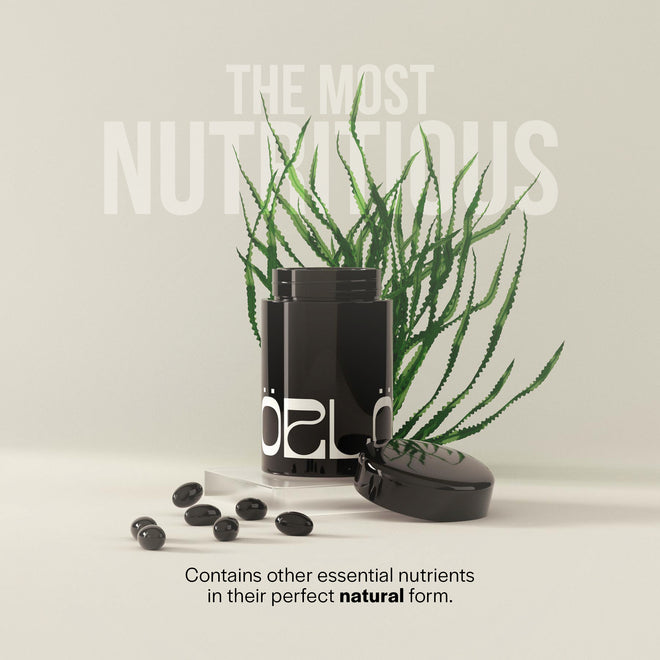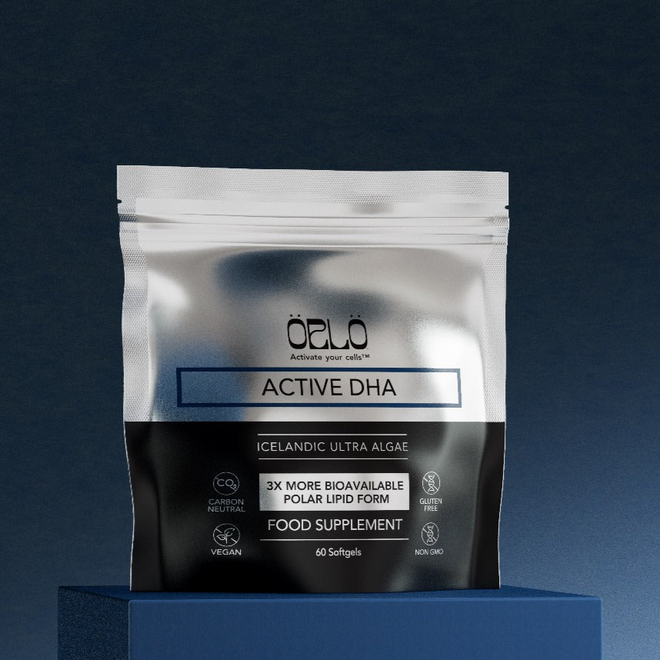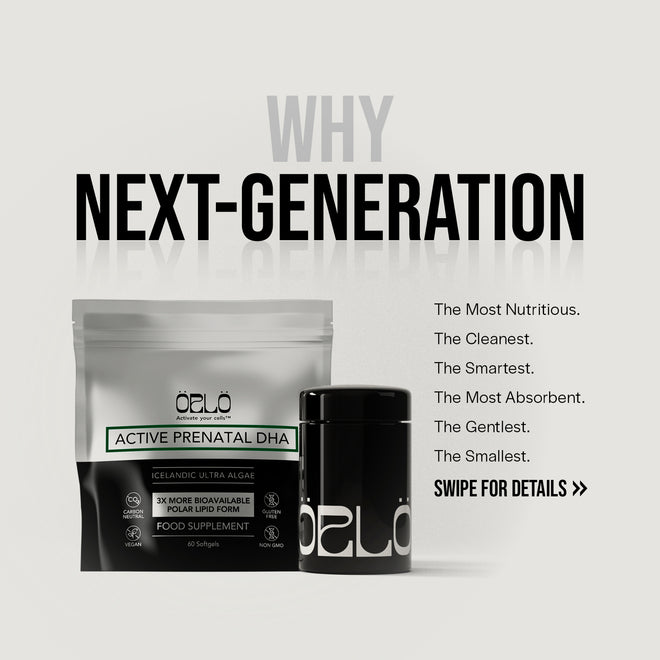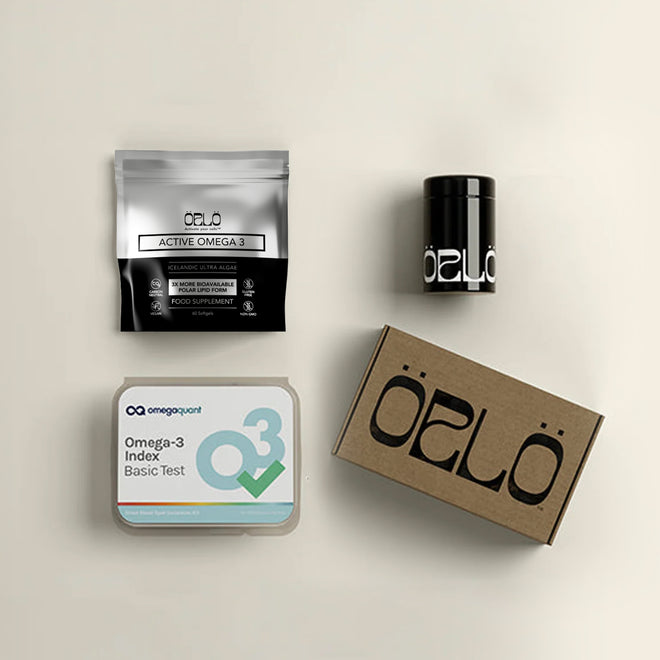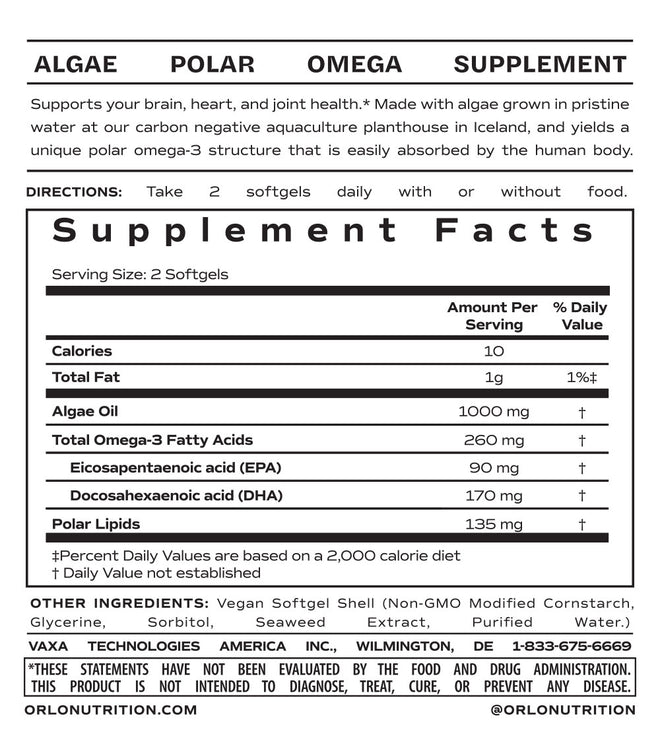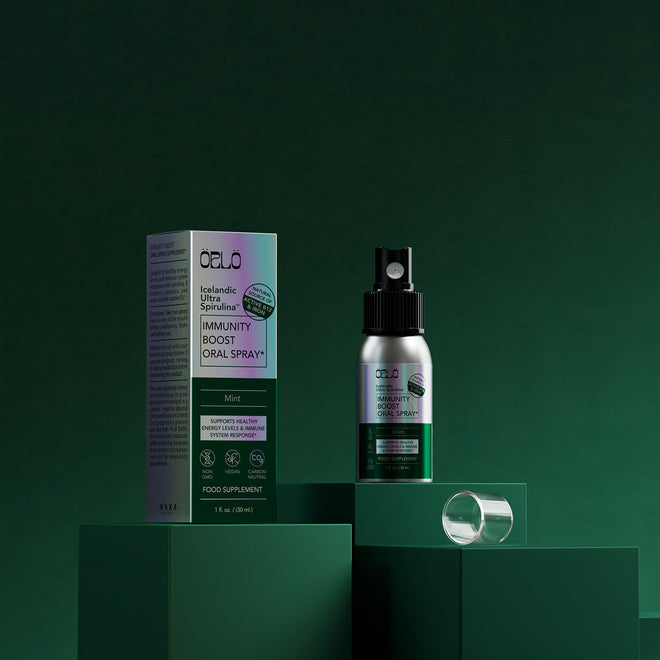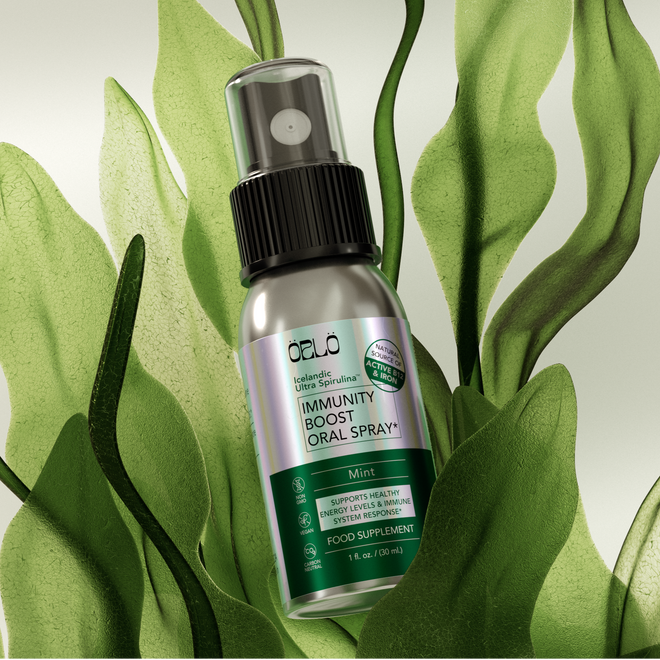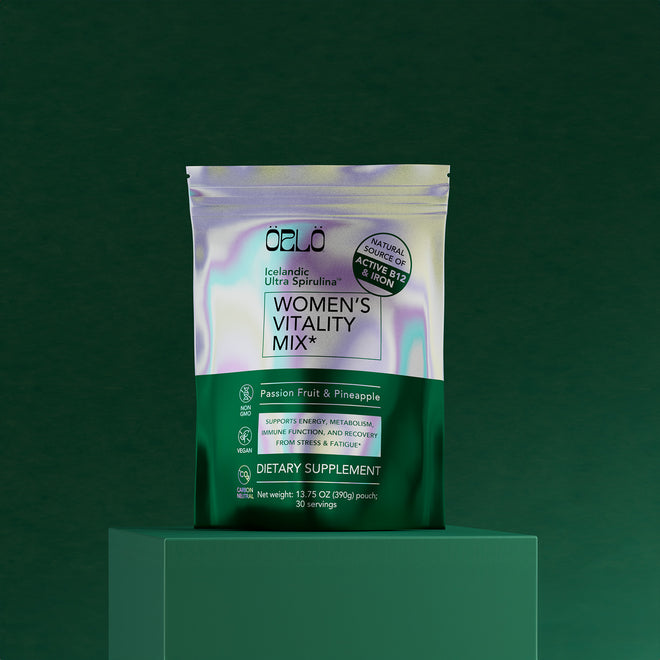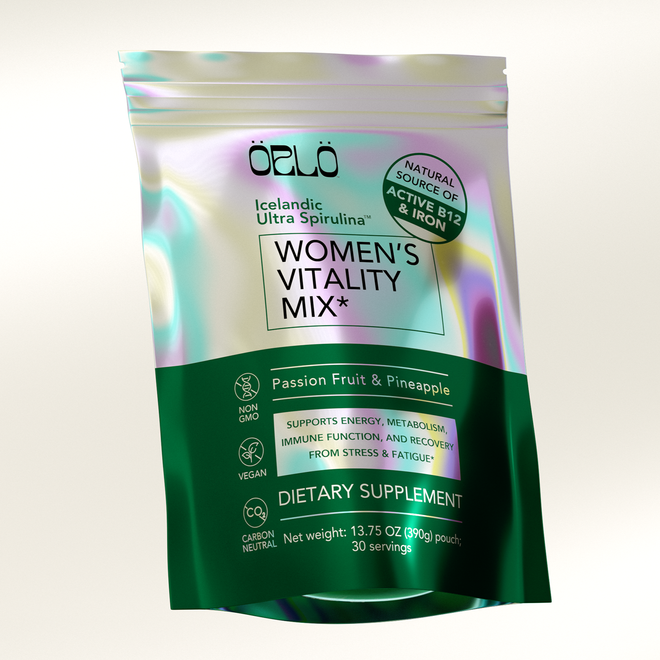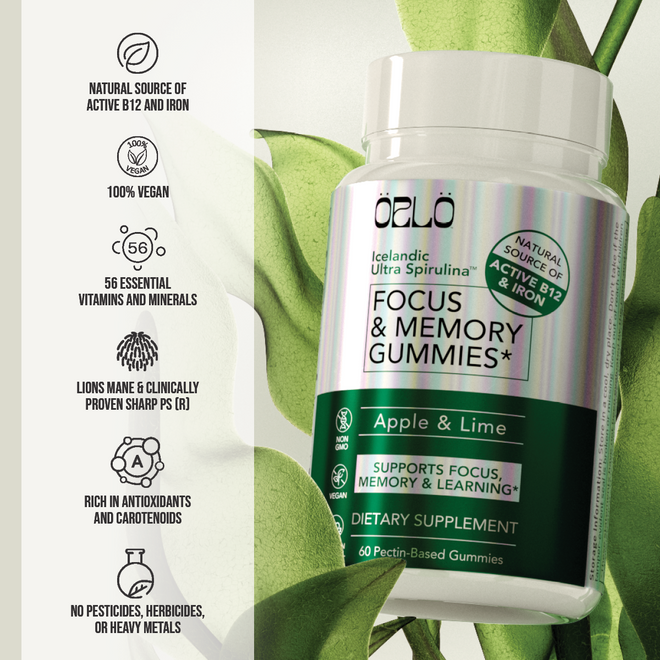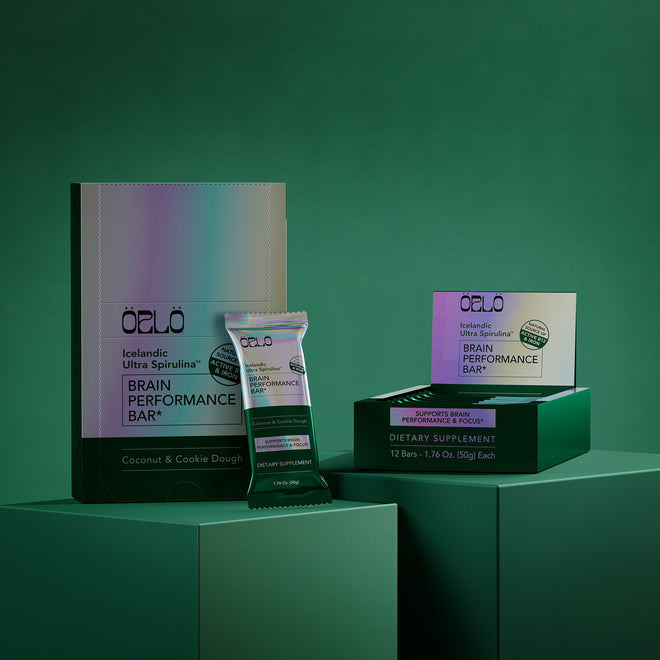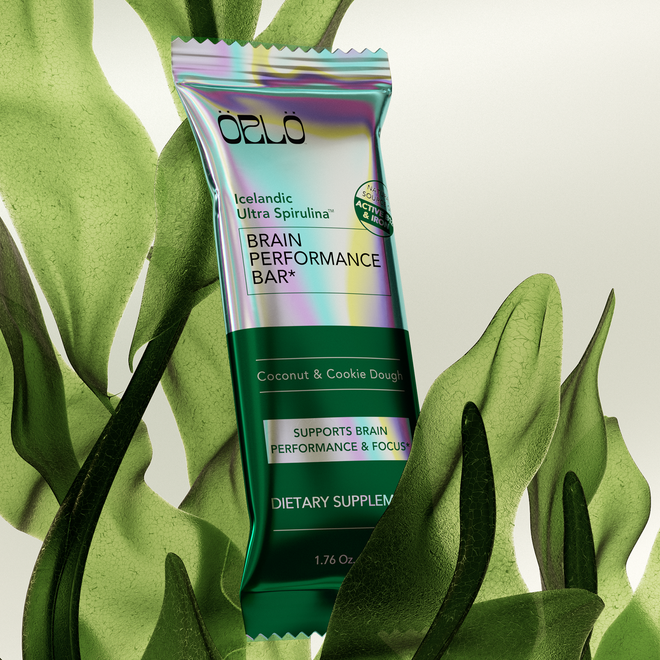Free shipping on purchases over $69
Earth Day Bonus: Why Algae Beats Fish Oil — A Sustainable Nutrition Deep Dive
Celebrate Earth Day with this inspiring bonus episode of Nutrition Without Compromise, featuring sustainability expert and podcast host Corinna Bellizzi. Discover how algae-based omega-3s and Icelandic-grown spirulina offer a powerful, sustainable alternative to fish oil — supporting your health while protecting ocean ecosystems. Learn about carbon-negative production, nutrient bioavailability, and innovative wellness formulas designed for modern lifestyles. Hosted by Rob Seaman of Whole Earth Radio, this episode dives deep into the future of food, regenerative solutions, and how mindful choices can drive climate action. Whether you're an eco-conscious consumer or nutrition enthusiast, this conversation offers practical insights for sustainable living — without compromise.
Watch the Podcast Here:
Listen to the Podcast Here:
Show Notes:
In celebration of Earth Day, we’re bringing you a special bonus episode from Whole Earth Radio featuring Corinna Bellizzi, host of Care More Be Better and sustainability lead at Orlo Nutrition. In this candid and wide-ranging conversation with Rob Seaman, Corinna shares her journey from building a legacy brand in fish oil to pioneering sustainable nutrition with algae-based omegas.
Discover how ORLO’s Icelandic-grown spirulina and EPA-rich microalgae are revolutionizing the industry with zero-waste production, carbon-negative operations, and superior nutrient delivery — all while reducing reliance on dwindling marine ecosystems.
What You’ll Learn:
- Why Corinna transitioned from fish oil to algae-based nutrition
- How microalgae like spirulina can support immunity, brain health, and postnatal recovery
- The environmental impact of omega-3 sourcing and how Orlo reduces ocean strain
- What makes Iceland-grown algae uniquely potent and clean
- The story behind Orlo’s taste-forward, innovative formats: from focus gummies to vitality stick packs
- How you can take action for the planet, one supplement choice at a time
Mentioned in the Episode:
- Women's Vitality Mix (NEW! ORLO Product)
- Care More Be Better Podcast
- Kiss the Ground and Common Ground Films (free on Amazon Prime as of today, 4/22)
- Paul Hawken’s Carbon: The Book of Life
- ForestPlanet.org tree-planting initiative: 1 tree planted per podcast subscriber
__________________________________________________________________________
Transcript:
Whole Earth Radio: Season 3, Episode 3 - Earth Day with Corinna Bellizzi
Rob Seeman: Hello, this is Rob Seeman and you are listening to Whole Earth Radio. Today is season three, episode three. My guest is Corinna Bellizzi, who is joining the podcast for the second time with me today on Earth Day. Which is a phenomenal celebration, everything important to the environment and the planet, which is a real through line through I think your career, Corinna and your life.
And thank you for being on Whole Earth Radio.
Corinna Bellizzi: Well, it feels appropriate to be here talking about what I'm doing to help the Earth today. So thank you for, for having me.
Rob Seeman: Yeah. Thank you. I know last time we talked a lot about Care More Be Better, which is your podcast in which you've had so many great environmentalists and, and scientists and activists and talk, talked about environmental justice and social justice and, and lots of different, um, aspects of the movement to, to make the world better.
But today we want to focus on. ORLO Nutrition, which is the Microalgae Nutrition company that you have worked with now for. It's been a few years,
Corinna Bellizzi: a hot minute, about four and a half years. But a lot of that was pre-market, as we were getting the parent company, VAXA Technologies, ready to launch a consumer-facing brand.
We had to look at how we would integrate the company's nutrients. How we would formulate with them, who we would use as our contract manufacturers to encapsulate our omega-3 oils in something like a soft gel. Because those things are generally not in-house, even when you are somewhat vertically integrated.
So we really had to run through the gamut of all that product development space to enter the market. In May of 2022, with a soft launch and then with a full production launch a little later that year. So we've been in the market for a few years now and we're making pretty incredible impact. We’re saving 110 fish for every one month supply of ORLO’s Omega-3 and DHA products that we put into the world.
So that's very direct impact we’re having every day. application. And in addition, just being able to show that we can utilize today's energy, energy, to grow nutrition sources as opposed to borrowing from the past by burning oil or fermenting sugars.
Rob Seeman: Yeah. You know, I had, uh, last season, Professor Isaac Berzen, who is the founder of VAXA Technologies and ORLO Nutrition. He’s a real innovative scientist in Microalgae. Folks can reference that conversation. I'll put a link to that of course. But I wanna reference, uh, your early career in Omegas in the industry because you've worked with many groundbreaking companies and helped them reach, heights of economic success in the Omega space.
This isn't your first rodeo as we like to say, but the first time around the company that you really took to the top was a fish oil company – Nordic Naturals. Do you feel comfortable talking about that in this space?
Corinna Bellizzi: Oh, absolutely. I mean, this is really what got me to want to dive into the algae space after all. The story behind the story.
Initially, I worked for almost a decade for Nordic Naturals as their second command. I led sales, marketing, and education and everything that faced consumers and retailers, which was over 70% of the business. I also indirectly led their international development and much of what they did in the professional market through doctors.
I worked to secure and maintain powerful partnerships with leading doctors like Joe Maroon, who is a team neurologist and neurosurgeon for the Pittsburgh Steelers, and collaborated with him to bring our message to a different audience and gain the ability to market our oils to the NFL. So it was really an incredible proving ground for not only my capabilities, but of architecting a model that would work well for the natural products industry and the direct-to-consumer and retail marketplaces. What drew me to the algae space was the creeping knowledge that no future could truly be sustainable for wild fishing, at least with how our environments are presently managed.
That is not only because of rampant overfishing or fishing piracy, but because of global warming and rising acidity in our oceans. In fact there's an entire documentary film about this called Seaspiracy, which is out on Netflix if people really want to know more. But, a word of caution is in order, because it can be difficult to watch at times, especially if you love marine mammals.
There are some scenes in there that I wish I could unwatch. But it really does go to show you that there's just more at play than any of us can really control. Things like: MSC certification – which is the “blue fish label” put out by the Marine Stewardship Council – claims there are sustainable fishing companies, but they don’t actually patrol or control what's happening in the oceans. That’s beyond their scope. No one is really taking responsibility for the health of our fish populations.
At the same time that you have these over-fishing activities happening, you also have to contend with the warming of our oceans. Our oceans are getting warmer every year and they're getting warmer, not only because of rising air temperatures, but because of the CO2 that the ocean is absorbing. With each bit of CO2 that the ocean absorbs, it becomes more acidic. And with that rise in acidity its temperature also climbs. So we end up in this perfect storm of environmental factors that are heating our oceans, and ultimately, at some point in the next 30 years, we could get to a point where our oceans are no longer, at least broad swaths of them, life-supporting, which could be a death knoll for us too.
I don't want to be the ultimate doom-sayer here, but when you see that far into the future, from a scientific perspective, you begin asking yourself questions. Do I really want to support fishing as an industry? No. Not in its present state. And when I came to that realization, I left Nordic Naturals, and I started working more on the algae side of the omega-3 industry.
Rob Seeman: Well, that's a great point. We want to not only walk a road toward sustainability by looking at the truth, and we want to motivate people into action, but we don’t necessarily want to focus on motivating through paralytic fear.
And the environmentalist movement has been criticized sometimes for using fear as a motivator. But I think it's a realistic perspective. And, you know, when you look at proposing a solution, for example, as opposed to just saying, this bad thing is happening… What are we going to do about it? You're actually giving people a way to make things better.
You're giving them, some way that they can act, a product choice that they can make. In fact, many different product choices they can make. It reminds me of the paper that Dr. Berzin wrote about cutting out the middle fish.
Corinna Bellizzi: Yep.
Rob Seeman: And I think this is a great idea. Let’s cut out the middle fish. Often, people act from the “what's in it for me” perspective as opposed to the “what’s in it for the planet” viewpoint, right?
Corinna Bellizzi: Mm-hmm.
Rob Seeman: So when you look at microalgae, particularly with the omega-3 microalgae, as well as the Icelandic Ultra Spirulina, you're doing something good for the planet, but you're really doing something good for yourself. So, do you think that makes this a really viable solution for anyone, not just for environmentalist and not just for vegans and not just for any one group.
Corinna Bellizzi: Well, I think it is.
We know that first of all, fish get their omega threes, EPA and DHA from the algae they consume. So that's the concept behind cutting out the middle fish. Right? We also know that algae give us oxygen. All these algae species from the microalgae to the macroalgae, like seaweeds and kelps that are growing in our oceans – they create oxygen that we breathe.
So if we start instead focusing on these nutrients, which come from the algae directly. That can be either farmed in open ponds using sunlight or the way we grow them at VAXA Technologies – in a controlled environment so you don't have to worry about pollution or toxins and things along those lines. And at the same time, we can use today's energy, such as geothermal energy.
We’re sequestering carbon. So you're bringing down, you're locking in carbon to this terrestrial plane and offering something that's consumable, that provides health benefit, and that at the same time is in a more bioavailable form. I mean, why wouldn't you do it if that were the case? That being said, I just had a conversation last week with Ben Kelly, who I brought on my podcast, Care More Be Better to talk about sustainability specifically as it relates to sourcing of ingredients. He's the co-founder of Algarithm the company that sold high quality Non-GMO DHA oil from microalgae. In fact, we partnered with Algarithm in our initial launch to use their DHA because we grow an EPA-producing algae strain. We created custom Omega-3 and DHA formulas that have naturally occurring polar lipids for 3X the absorption over fish oil. They come from algae as opposed to wild-caught fish, which is really a phenomenal way to look at your overall sustainable nutrition.
And that’s especially true when you can also sequester carbon – and when your byproducts are not negative to the environment. In our case, a lot of those byproducts are more like co-products. They exist within the Softgel. We're giving you proteins. There's chlorophyll, other micronutrients like vitamin A. There is a complete style of nutrition with algae as it exists because our oils are so clean they can be minimally processed.
Microalgae represent the first documented life on earth. They are billions of years old, and the fact that they can play a role as both a nutrition solution and a climate solution is truly poetic. So I really think more people should be looking to algae instead of fish oil. And at a certain point we're going to be forced to transition to algae over fish, whether or not we choose that solution.
Right now, 95% of omega-3 supplements sold come from fish, and some of those sources are already hugely overfished or from questionable origin, as with shark liver oil, or calamari oil. These fish-based sources have been produced at a flat level for the last several years, even as omega-3 consumption rises 3-5% per year. Right now, perhaps 5% of the market is algae-based, but the tides are turning. Algae-based omega-3s are growing faster. This is not only because plant-based and vegan options are rising in popularity, it’s because awareness is increasing, and people want sustainable solutions.
So people are getting really creative, like what are more sustainable sources? And one, um, that's interesting on the plant-based side is like this, AHI flower extract, which contains the omega-3 alpha linolenic acid, but for all the nutrition nerds out there. ALA is a precursor to EPA and DHA – but it’s not a source of EPA or DHA. And you're not going to get the total omega-3 levels in your cells to reach the ideal 8-12% unless you're consuming direct sources of EPA and DHA either from fish or algae.
You're going to need a direct source of EPA and DHA if you wanna see dramatic health impacts for your brain, for your eyes, for your heart, for your circulatory system, for your mood, for your joints, all of those things. You know which one I’m choosing. I take 4 softgels of our Active Omega-3+ every day. Sometimes I throw in the DHA in its place, but mostly – I need 4 softgels a day, or 2 full doses, because I don’t eat ANY fish anymore.
Rob Seeman: Well, you know, it's such a great point because I remember in the industry, you know, from the period where I came into the natural products industry in the mid nineties somewhere, uh, to really, you know, I wanna say early two thousands even, you know, in some corners, maybe even today, I. There was, uh, this idea that flax oil was a viable source of omega threes.
And you know, that it really speaks to people not understanding the different forms, you know, the long chain versus the short chain, what's usable. And you know, you, with Nordic Naturals, were able to successfully educate the marketplace that it's not just Omega-3, that's the buzz word. But EPA and DHA are the specific forms of Omega-3 fats that you, that you need mm-hmm.
Uh, that your body will ultimately require. These are essential, uh, forms. And so I think the fact that you're able to create these with a plant with algae. Um, kind of circles back to what people thought they were getting, uh, in, in the earlier days of the industry. And it, it's interesting, I think at some point, you know, we were able to convince people, look.
You really do need DHA, you really do need EPA. But, um, it, it's an interesting, um, consumer circle I think of information to where people, you know, realize that they need these nutrients, but they're, they're, you feel like people are just now getting the message that there is EPA and DHA that is plant-based and that, that, you know, that's a viable option.
Corinna Bellizzi: Yeah. Well it's interesting because all those vegetarians vegans that were hard to convert to fish oil in the past, some of them still have this mindset of, no, no, I'm just fine with flax oil. I've even heard. The comment coming through from some vegetarian circles that they don't see algae as being a vegetarian or vegan product.
And I'm like, wait a minute, why? What's going on here? Why do they think it's not a plant? And this comes from a misunderstanding from the cyanobacteria perspective. Spirulina is an example, is a cyanobacteria, right? That said, so it acts very much, um, in certain ways like a bacteria, but it is, photosynthetic and it's like a plant nutrient, right?
It's not a multicellular organism the way we might can think of other things. So they're, they are literally thinking of spirulina and other cyanobacteria when they're saying that they don't understand that nano coreopsis is literally a single cell little. It's like its own chloroplast floating around in the water, right?
And so we have algae strains that are grown specifically for omegas, from the schizochytrium to the nannochloropsis that we grow, producing nutrients like EPA and DHA. Each fish and the ocean that accumulates these levels of EP and DHA, they're either accumulating it specifically because they eat the algae like the smaller bodied fish, sardines and anchovies.
Or they're accumulating it from being predatorial fish and eating smaller fish that eat the algae and all that. Right? So, and you're still getting the EPA and the DHA, the original life force from microalgae, no matter what you do. And even the plants that ended up on our shores, the flax that's growing and all the other, um, plants in the, in the, that entire plant kingdom, they started out at 1.3 and a half billion years ago as an algae.
So it really is the center of, um, the creation of life.
Rob Seeman: Yeah, that's, that's such a great point. And I, you know, I just wanted to, uh, pivot a little bit here to talk about the spirulina part of the reason, you know, we're here to talk about how important, uh, your spirulina is, how orlow spirulina is so much different, you know, where it's grown in.
Iceland certainly has this wonderful, um, you know, uh, environmental footprint, which is. You know, smaller than just about anything else, but also the vertical integration, right? Like the closed systems that, uh, spirulina has grown in there. And I guess that would apply to all the microalgae that, uh, Voxa or LO is growing, right?
So, uh, you could talk about maybe. The difference between algaes, right? So if someone is buying an algae, uh, spirulina or, or any other kind of, uh, opsis or whatever it is that's grown in an open tank, I mean, we literally are talking about tanks that are open to the environment in terms of. Pollution and things falling in and, you know, decaying, uh, organic matter falling.
Corinna Bellizzi: Oh, I feel like Isaac probably talked about this a a bit already, but you literally have incidences where you. Have documented like seagulls, you know, fly over and, and guess what birds do when they're in mid-flight? They, they still poop, right? I think, um, I've been on a campus at school where there were a bunch of seagulls that would just like erupt every time there was a lunch break, right?
From all the tops of mountain or not. Mountains are just. The buildings and things, and so you'd be like duck and cover, almost want an umbrella just to get through the quad without getting targeted, it seemed. So yes, that falls into these open ponds. Some of these open ponds could be the size of multiple football fields and essentially just have the water circulating slowly through to ensure that the algae itself doesn't get burned because the UV light itself.
Can actually burn the spirulina. The same thing happens when you're growing algae strains that are photosynthetic that produce omega threes. You need to have a certain amount of oscillation so that they can cycle through the top of the water. And get enough light, but also not get burned and get, you know, their, their temperature needs met, needs met because they get too hot or they get too cold, then things can go wrong, right?
They just simply won't replicate or they will die. And so. You know, the, the primary growers for Spirulinas have continually battled certain issues with environmental toxins. Like you'll produce a spirulina and you'll find that it has higher levels of heavy metals and lead. In particular then you'd like to see, and particularly if you're going to sell your product in the state of California, because California has this beautiful thing called California Prop 65, which is designed to protect consumers from high levels of lead.
In certain things, or PCBs, other environmental contaminants. So you don't wanna have high levels of these things in consumables, especially those consumables that are considered. Let's just say superfluous, like it's not a core food. You won't see, um, a steak of salmon with a label on it that says Violation of California Prop 65.
But you'll see that pancake mix that has, you know, a higher level will bear a warning if it has a certain level of lead. Saying things like, the state of California knows that the levels of toxins in this product may contribute to. Birth defects and things along these lines or cancers. So it's, um, it's a real challenge and has been a real challenge for some time.
In fact, for a long time you couldn't find a greens bar because people were getting litigated against for having high levels of lead and, uh, simple greens bar that had spirulina in it. If you buy a, a pouch of AG one and you live in California and it ships to your door, you're gonna see that California Prop 65 warning on it.
And this is because of the spirulina source. Now we grow our spirulina indoors and these vertical tubes exposing it only to the light that it needs to thrive, which is a perfect mix of blue and red. No uv. It doesn't burn right. We're able to moderate it's temperature 'cause it's a fully controlled environment.
If it's too hot outside. It doesn't matter. Too cold outside. Doesn't matter. Guess what? We're in Iceland. It's too cold a lot of the time, but it doesn't affect our indoor growing conditions. And this does a couple of things for the algae itself. One is it seems that it actually produces higher potency of core nutrients and in their more bioavailable form.
In the case of our spirulina, we've identified that it produces vitamin B12 in the methyl cobain form. If you're to look at spirulina grown in open ponds, it produces a B12. Agonist, it's like a pseudo B12, which is um, ultimately will sit on your receptors and your cells and prevent absorption of B12.
Vegans and vegetarians are concerned about getting enough B12, so you know, you can take our spirulina and maybe not anybody else's, but you can take our spirulina as a solid source of vitamin B12, and that's why you'll see B12 reflected in our women's vitality mix, in our brain performance bars, and even in our gummies that.
Our focus in memory gummies, these three products, um, and or immunity boost, they all bear B12, which is coming from the spirulina itself.
Rob Seeman: And also, uh, iron as well, right? Among these nutrients,
Corinna Bellizzi: which is relevant. Yeah, iron. We quantify the iron and the B12, and if we include enough of the nutrient, meaning that it bears more than 20% of the recommended daily intake on that particular product, as long as we're crossing that threshold, then we're also claiming it on the label and supplement facts.
I'm so sorry. My dogs are telling me a package is here.
Rob Seeman: It's all good. It's the ultimate, uh, doorbell. Uh, you got the dog ring?
Corinna Bellizzi: I do. I have the dog ring for sure.
Rob Seeman: But yeah, I, I think that's, um, you know, uh, like with the Women's Vitality powder, that mix is, you know, to me, making great use of the natural.
Nutrient profile in your spirulina in or spirulina to find a unique formula Formulary use, I would say, right? As opposed to just giving people just spirulina. Here's, here's this amazing spirulina. And I think, you know, to me it looks like the way. Uh, Orlow has been formulated. The, the products, you know, this first and second wave of products is very current, very modern, you know, in terms of reaching a new generation of consumers as opposed to the people, you know, the, the, uh, folks who taking spirulina for years, right?
20, 30 years ago, people were, uh, kind of, uh, closing, closing their eyes and holding their nose. Eating this stuff that tastes terrible and they're not used to products that actually taste good made with microalgae.
Corinna Bellizzi: That's been the barrier. That's been the barrier to the mainstreaming of them because people think of it as pon scum or something like that, and when you grow your spirulina or you grow your algae and these really controlled environments using this beautiful fuchsia light, that's a perfect blend of the blue and the red.
When you physically open the doors of your plant to bring people inside and they remark, oh my God, it doesn't smell like anything in here, and they can taste the spirulina directly out of our tank, just filtered through a mesh. That it doesn't have any flavor at all, aside from a mild salinity that it gets washed for because we have to grow it in a somewhat, um, salty water.
It's like a, a brackish sort of water, right. For it's optimal growth. And you know, at the end of the day, you produce something that has literally no aftertaste or flavor. Um, I have actually the women's vitality mix right here in a jar, but, oh, nice. What I, what I wanna say before we get to that. Is that the way we're growing, the fact that we're able to get all, all the essential amino acids are in the pro, in the spirulina itself, the fact that it only has to be very minimally processed.
We don't have to worry about toxins or environmental contaminants or you know, hey, a dead lizard in your pond or whatever. We don't have to worry about any of that at all. Um. We can produce something that just is very, very clean. Clean to the pallets, can be minimally flavored, can be flavorless. I've actually seen out of our production, um, you know, a liquid blue that, uh, they were just testing like, here's a 7% aqueous extract.
You know, mix it with whatever in your kitchen, and tell me what you think. So I've done things like, put it in my smoothies, put it in my frosting, put it in my yogurt. And it literally just makes food blue, which is fun, and the kids love it, and it hasn't had any negative impact. Right? We're now to a point where we're offering our spirulinas and ingredients to a bread company in Iceland called Broad and Co.
They're putting just 30 milligrams, 30 milligrams of the powder purse equivalent serving of the bread, and gives 20% of the daily value for B12. It gives iron and all this other stuff and it tastes delicious. It's. It's not, you don't taste a difference. It's just whatever the formula of your bread is, is how it tastes.
So the fact that we can do this and there's no organoleptic negativity, meaning it doesn't taste or look bad, is really incredible. So in this formula, you know, I've got this little jar here. I, I brought it to kind of demo for anybody that is watching this on YouTube, my like trusty dusty water bottle here.
But when you, you know, it's fully water soluble. So if I just pour this in. You see that the blue starts up right away, right? Yeah. And it's a blue green algae. Um, and this hasn't even been mixed yet. And so instead of using a shaker ball, because that would be very loud, I brought my little mixer, but I mean, okay.
Yeah. Very
Rob Seeman: vibrant color. You
Corinna Bellizzi: shake it, it's like a, a blue beer almost. Right? And in fact, we've tested this. You can take our blue algae and put it in. A beer and you can make a green beer if you're using a lagger for,
Rob Seeman: there you go.
Corinna Bellizzi: It's just a nod to the future because we are going to be, um, doing a Blue essence product that will be offered and a little liquid dropper that you can add to anything you want to flavor or taste or, you know, make blue frosting if you want for your kid's birthday.
Um, it makes for an interesting yogurt, popsicle smoothie, whatever, just because you're able to show people. Um, a nice color. It's also been used in things like cocktails. You know, make it a little healthier. Give yourself some B12 with it. Maybe that will help prevent the next day's hangover.
Rob Seeman: Right? So many applications there, right?
Corinna Bellizzi: Right.
Rob Seeman: So often those plant pigments are what a lot of the antioxidant and phytonutrient value in plants, wherever they come from, you know, it, whatever gives it that color. So often what has the most antioxidant activity, right? It's true in berries, seems to be true here, you know, to some extent with, uh, with chlorophyll and FICO in, in the, uh, the allergies.
Corinna Bellizzi: Oh, for sure. And the other thing to think through on the very tail end, especially as this is coming through on Earth Day, is that our waste at the end of the day, after you've extracted what you want and what's left behind, is essentially soil amendment that will lock the carbon with some core nutrients.
Of the ground for the next 30 years that essentially supports the growth of plants for, for food, or for whatever else. And so this is part of the reason that we actually have carbon credits to sell. So you could really confidently say that oil and nutrition and vexa technologies are carbon negative companies.
Rob Seeman: Well, and I think that's a, you know, a great point. I think when you have the intersection, you know, here we are on Earth Day talking about sustainability, but also, you know, the point I always try to make with these things, you know, we're not asking people to sacrifice. We're actually, uh, giving them additional benefits.
So, you know, you're doing something, it's good for you, it's good for the environment. Um, those. Two things together, you know, are enough to win a lot of people over, but it, we're all about convenience these days. So I think the things that I see that Orlow ISS doing to make more convenient to consumer products, like with on the women's vitality, the, the stick packs.
Corinna Bellizzi: Yeah. I've got that right here. This is the first production run, but it's really beautiful. We got this, um, holographic and the stick packs come in a pack of seven and then. Each stick pack is one serving. So, um, really this is initially formulated as a product. It was designed first to be a, um, post. Birth, so a postnatal product, but as we really got into looking at all the nutrients, I'm like, there's no way that this is only for women after they give birth.
Like really, it is designed to help handle stressful times, recovery from, you know, overexertion. The fact that there are a combination of nutrients like from the magnesium and zinc to support the immune system and things along those lines. To the potassium, um, the glycine, razzi, cranberry fruit, and then the probiotics.
We put spore form probiotics in here as well to help heal the gut. And so all these things together with vitamin D and protein and just the spirulina as a whole, it's, it makes for a really incredible product. And this one is flavored with passion, fruit and pineapple. It has a mild saltiness to it on the finish.
Um, and that also comes in part from the potassium citrate. Um, so it's really, I think, an incredible product. I've even mixed this in my smoothies. Um, so it's like I'll take my protein and all these other things and ends up being kind of a, a bluish pink in the end because of all the strawberries I put in there.
Um, tastes delicious.
Rob Seeman: That's such a, yeah, that's such a great point. I mean, you know, it, it's delicious. People have associated spirulina with. Being, uh, a chore to take in the past, but jambo
Corinna Bellizzi: juice, juice boost days, you know,
Rob Seeman: this is the next generation of microalgae. Right. And because you have a tastier starting material that is grown in all those ways, we've been talking about, you know, sustainably, vertically integrated.
It yields a better taste or a taste that isn't strong and polarizing, like, uh, microalgaes have been in the past when you put that in, like the focus in memory gummies. You know, we just did, um, whole Earth. We just did the America's Beauty Show.
Corinna Bellizzi: Oh yeah.
Rob Seeman: Which yield And, uh, Rosemont here in Chicagoland. So we were talking to thousands of cosmetologists uh, beauty students.
You know, just average consumers that are not, you know, let's say quote unquote health food shoppers. If there were little, uh, group to put, you know, there's people in, it would be beauty professionals and associated consumer, uh, base. But, you know, with the gummies, I think it was really, um, interesting. To people have people walk up and say, you know, do you want to try this?
And they say, well, you know, some people ask, how do you get that green color? And when you tell 'em, oh well it's from microalgae. From spirulina, um, you know, that's, that's where the green, yeah, it's
Corinna Bellizzi: literally bluegreen. Which is why we had to choose flavors that went with green. So that's why we said green apple, or green apple, lime, you know, even though.
There's all these berry flavors available to you and you're like, it just sounds weird to have blackberry and then have it be green. You know, like you expect something different. Green, it's a unique flavor. It tastes good. Um, and what I love about this particular product over so many gummies out there is that you're getting a.
Really active standalone dosage level of the nutrients that are in there, including the Syl Seine. It's a sharp PS, a hundred milligrams of that, a hundred milligrams of L-tyrosine. And these things work together to give you kind of calm, sustained mental clarity. Which is really critical and important and sharp PS itself, in combination with that B12 from the spirulina, et cetera, is really shown over time to be more and more effective.
So you get a stronger effect over time. And so far people are really loving the product. Um, I, you know, the dosage is just two gummies and it tastes good. So, you know, it's not a lot to complain about.
Rob Seeman: Yeah, I think that's, you know, making a product that actually tastes good where you're not sacrificing nutrition.
I think with gummies, all too often we see products that have too much sugar, not enough actual therapeutic nutrient, and that's why they taste good. These are, I forgot to
Corinna Bellizzi: mention, the lion's mane.
Rob Seeman: Oh yeah.
Corinna Bellizzi: And Lion's, Maine taste good too. But this one. Has a standardized version of Lion's mane, so it's the lion's mane mushroom extract, 200 milligrams.
An extract is of course, much more potent than it's standardized to beta glucans one three and one six. So you're getting nutrients that also support your total body system that are known to be nootropic and ultimately an effective product. And that's it. You know, you wanna produce effective products.
So much of what is out there, especially in the gummy space, unless you're just getting some basic, like vitamin C or B12, is, you know, I kind of throw up my arms and go, okay, this is fortified candy. A lot of it, I mean, there's still sugars in this, but you're getting so much out of what you're putting into it that I, I just feel really confident in it.
So it's just four grams of sugars, pectin based vegan products. All of our products are vegan.
Rob Seeman: Yeah, fantastic. I think that, um, you know, so much of what you're doing is really on point with the brand. Um, you know, I've seen a lot of great response and I think that's really what you have to do in this day and age is bring people a product that meets them where they are.
In other words, it, it has to taste good, and if they're a more discerning consumer. You know, in talking to folks, as I have quite a bit about the gummies, you know, the, uh, the phosphatidyl searing is you mentioned, you know, a really important, uh, neurotropic ingredient, but you, you don't see it as much. You know, it was more like, uh, 20, 30 years ago.
It was
Corinna Bellizzi: very hot in the nineties and early two thousands. Definitely. But, you know, it's not that the science was bad, it's just, you know, you have flavor of the minute, and lion's mane is more flavor of the minute, which is why we also included it.
Rob Seeman: Well, you don't have to choose, right? You could have, you don't have to
Corinna Bellizzi: choose.
We did both.
Rob Seeman: You could have lion's mane and tidal sired and, you know, the Icelandic, uh, ultra spirulina. Mm-hmm. And all the, the broad spectrum of, of, uh, nutrition that comes with that. So it's really, they're really great formulations. I think not just having, you know, most companies that do, um, grow ingredients in this vertically uh, these verticals, you know, where they're, um, pioneering technology and there really aren't.
That many of them. Right? So Voxa is kind of in a category, um, that not that many companies are in, but to then also launch them. Using unique formulations that are innovative and speak to the market. You know, I, I think it says a lot about what a great project this is, you know, because you have, you know, great ingredients, but also great formulations.
And, uh, that, that to me really says the most about the, the brand.
Corinna Bellizzi: Well, and if you're coming from that lens of sustainability. The product that you'll remember to take that does you the most good that you're going to really enjoy and continue taking. That's also mindful of resources at the same time.
Like that's really the product you should be taking, not the one that just is gonna sit on your counter and get dusty and take up space. And so many people, I think we. Have the best intentions. We go and we grab something and then we have it in our cabinets and we forget all about it, right? We've both spent money on it, and then who knows if it's been consumed by the time it's starting to expire.
So, you know, if you have a product you enjoy taking, you're more likely to take it. That's where you get into these multiple types of, you know, just different deliveries from a liquid to a gummy or something along those lines. And in the case of our immunity, boost a spray. Small enough to put in your purse, you know, just couple sprays twice a day.
You're getting vitamin D, B12 and some other things along with the spirulina. And you know, they're, because they're portable, because they're easy to take. It's easier to remember them. The omega threes being in a beautiful glass jar that you then place on your shelf. I mean, you buy the, the pouch and you refill this.
So we sell starter kits at retailers. We also sell them from our website, and then the refills can just be the standard pouches that you receive. Um. This is the four pack packaged for retail, but a pouch made with post-consumer recycled plastics as opposed to something that's all virgin material. So we've really been mindful at every step of the way to try and reduce waste.
I. Because when you think about the waste at the very beginning and you work to reduce it to a negligible level or use recycled or reusable materials, then the the world that you'll build is going to be more sustainable, even so, so. It's really something that we think about at every step in our, in our processing from our plants to what we do to bring products to market.
You know, we don't do a lot of printed materials. The printed materials we do make are ultimately for training purposes to bring into retailers like those that you are supplied with, and then also things like shelf talkers to help communicate the message. Um, and you know, that really is the wave of the future.
Less paper. Every single piece of paper is equivalent to two gallons of water and processing. You don't think about the water inputs, but fresh water is used to process paper right beyond the tree. And then you have FSC certified forests, or not certified forests. So it's just like there's so much that can go into this kind of lens of sustainability when you're bringing a product to market.
And we really work to do. Um, the best we can. We're presently looking at whether we can come into an aluminum bottle, and so we're exploring that as well. Wow. And, uh, you know, that would get shift us away from using a plastic on something like the gummies. Um, and if we get to the point where we actually are replacing this refillable glass jar, it's beautiful and perfectly preserves the oil to something that.
Can be on the shelf, easier to grab, um, for the retail marketplace, then we may go there. But, um, again, looking at something like aluminum, which can be infinitely recyclable as opposed to plastic.
Rob Seeman: Yeah. From cradle to cradle. Right.
Corinna Bellizzi: From cradle to cradle. That's right.
Rob Seeman: Well, I, I really appreciate it, Corina.
This is such an important product line to me and I appreciate your taking the time and going through some of the products. I did just wanna touch on just for a minute, it being Earth Day and everything Care more, be better. Can you just maybe tell us about a few of the recent guests you've had on that, that tackle the sustainability issue and, um, some of the, the podcast of yours that they should check out?
Corinna Bellizzi: Yeah. You know, I've done so much specifically on sustainability as a topic from multiple lenses, whether it be from the fashion industry or regenerative agriculture, or even just looking at how we're building a sustainable future, even through. Things like, um, creating art projects that help us to get that message out there.
One episode that I'm super proud of is an interview with Donna Grantas, who was inspired by an earlier episode where I interviewed Donna Grantas on this podcast. She is an exceptional guitarist who trained with Prince. She was a musician who played guitar for him for some time. Uh, she's recently undertaken a project with Dave Grohl.
She reached out to me. Because she was, um, in particular impressed with an episode where I interviewed Sah Berman of the Fossil Fuel Treaty and Stand Earth, and so she asked if she could use clips from my interview with Sah Perman. Um, which is spelled B-E-R-M-A-N, I think that's her last name. And she integrated that into a spoken word guitar solo that she launched at a Toronto Music festival for Earth Day that year.
So this is a slightly older episode, it's a couple years back, but it's one I'm super proud of. And she created this song that then ended up out in the world with projects including Brian Eno and, um, the. The exposure of that song then meant that dollars were being donated to earth oriented projects along the way.
So it just was something that was very fulfilling because here I was doing something I was passionate about, talking about things like why we should cease having this drill, baby drill perspective when it came to our earth. And then it ended up kind of spiraling into all of these particular spots that just, um.
It really was seamlessly beautiful. Another, um, a couple of interviews I've done that I think are just fantastic. I've interviewed Paul Hawkin twice on my podcast. He just released a book called Carbon The Book of Life, which was an incredible journey. I did an episode feature where I literally went through quotes in the book.
I I, I'd read the whole book and I essentially did a half hour book report on it as a podcast, both audio and video. I. Um, and then his interview was aired a couple of weeks later. And then because this is Earth Day, I should also mention that I interviewed Josh Tickle, who is the gentleman, the film producer, along with his wife Rebecca Behind Kiss the Ground and Common Ground Films, and they are both available as of today.
For free on Amazon Prime. So if you haven't seen these films, kiss the Ground and Common Ground, you should add them to your list and go watch them. They'll, you know, it's the first time that they've been offered in that way. You could have seen Kiss the Ground before if you had a Netflix subscription, but this is just one more way that you can learn about regenerative agriculture, get to see some of your favorite actors and um, Hollywood producers and really.
The people behind the scenes and in front of the scenes that are supporting a movement to bring carbon back to earth and really, um, start to move the needle and reverse climate change. A reverse global warming, I should say. Climate change is constant, but reverse global warming,
Rob Seeman: right? No, yeah, that's a, thank you for making that distinction.
Corinna Bellizzi: There is one more initiative I undertook this year. I'm planting a tree for every subscriber to the show. I'm doing this through Forest planet.org. So if you find Care More, be better on Apple Podcasts, Spotify, or on YouTube, and you subscribe to the show there, I'm planting a tree in Your Honor. My intention is to.
Continue planting trees through the end of the year with a goal of 20,000 trees. Um, but I think I'm well ahead of that so far. To date, it's over 7,000, so my hope is to be able to hit that 20,000 mark by the end of summer. I.
Rob Seeman: Wow. That is fantastic. Well, I think that is a great, um, sort of embodiment of the change that you are working to make and to encourage others to make.
And I think, you know, it's, it's just, it's gotta be so many things. I mean, the, the damage to the planet, um, is not. Happening in a small little box, right? It's happening on many levels. So the fight to, uh, stem the tide of, like you said, a global warming really has to be a dynamic. It has to happen on many fronts that have to be many conversations in many aspects of the world and of society.
And you've done a lot to push the conversation forward to disseminate the information. Um, to work with products that are part of the solution. So thank you for all of that, and thank you for joining us on Whole Earth Radio to, to give people, you know, a little, little, uh, some insights into what all you're doing and, and where it's going.
And, uh, you know, we'll have to have you back on again. And, uh, I'm sure there'll be lots of new stuff to talk about then. But, um. For today, happy Earth Day.
Corinna Bellizzi: Happy Earth Day. I'm so glad I was able to be here today, and I hope you just have an exceptional next year of the podcast. Season three is nothing to scoff at!
Rob Seeman: Thank you so much. Take care, Corinna.

